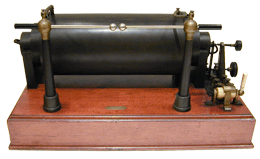|
The spark coil
formed the heart of the earliest radio transmitters. Marconi
used a Rhumkorff coil similar to the one below in his
early experiments. A Rhumkorff coil combines the
spark coil, interrupter, and spark gap all into one
unit. The coil essentially operates like a huge buzzer: The
interrupter's contacts are wired in series between the
battery and the coil and are closed in its resting state. When
power is applied, the coil is activated which produces a
magnetic field at the metal core of the coil. This pulls the
interrupter contacts open, breaking the circuit. The falling
magnetic field relaxes its hold, the contacts close, and the
entire cycle repeats.
The rising and falling magnetic field of
the primary coil induces a high voltage across the secondary.
When the voltage is high enough it jumps the gap creating a
spark. During the time the spark is present there is a high
frequency alternating current field radiated from one pole of
the spark gap.
The output of a spark gap transmitter is
turned on and off by the operator using a special kind of
telegraph key, designed with large contacts to carry the heavy
current. I have several of these spark keys in my collection,
you can click
here
to have a look.
 |

Simple Spark Gap
Transmitter |

Early Sullivan Wireless Rhumkorff
Coil
(With 01A for scale)
c. 1895 |

Marconi 10" Spark Coil
c. 1910
|
|

Wireless Spark Coil
c. 1880

Weitzmann Rhumkorff Coil
c. 1900
|

Interrupter for Wireless Induction Coil

Small Weitzmann Rhumkorff Coil
c. 1900 |
|

E.I. Co.
1" Spark Coil
1914 |

E.I. Co.
1.5" Spark Coil
1914 |

"Bull Dog" 1/2" Spark Coil
E.I. Co, 1914 |
|

Splitdorf Spark Coil
Patent Date: 1898 |

Early Dow Spark Coil |

Queen & Co.
Induction Coil |
|

APPS Induction Coil
1891 |

W. Watson & Sons Rhumkorff Coil
(British)
c. 1895 |

Bing Spark Transmitter
with Rigi Spark Gap
(German)
c. 1905 |
|